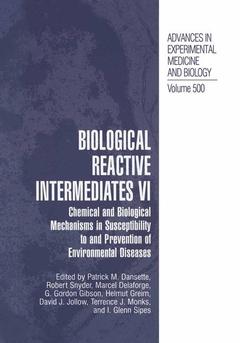Biological Reactive Intermediates Vi, 2001 Chemical and Biological Mechanisms in Susceptibility to and Prevention of Environmental Diseases Advances in Experimental Medicine and Biology Series, Vol. 500
Langue : Anglais
Coordonnateurs : Dansette Patrick M., Snyder Robert R., Monks Terrence J., Jollow David J., Sipes I. Glenn, Greim Helmut, Gibson G. Gordon, Delaforge Marcel

This volume presents a discussion of the biological effects produced following the metabolism of xenobiotic chemicals to chemically reactive metabolites, i.e., toxic and carcinogenic effects, which have been the basis of all five earlier volumes in this series. In particular, this volume devotes sections to structure-activity relationships, recent advances in the understanding of the chemistry of reactive metabolites, and the generation and activity of reactive oxygen species with special emphasis on nitric oxide. There are also segments on DNA damage by reactive metabolites and DNA repair, tissue specific responses to BRIs, and human health effects of BRIs. The papers that comprise this volume were submitted by workd class scientists who were in attendance at The Symposium on Biological Reactive Intermediates VI at the Universite René Descartes, July 16-20, 2000.
Keynote Presentation; S. Orrenius, et al. Session I. Structure Activity Relationships for the Chemical Behaviour and Toxicity of Electrophilic Quinones/Quinone Methides; I.M.C.M. Rietjens, et al. Use of Structure-Activity Relationships for Probing Biochemical Mechanisms: Glutathione Transferase Zeta Conjugation of Haloacids; P.D. Swartz, A.M. Richard. Structure Toxicity Relationships - How Useful are They in Predicting Toxicities of New Drugs? S.D. Nelson. Session II. Biological Reactive Intermediates in Drug Discovery and Development A Perspective from the Pharmaceutical Industry; T.A. Baillie, K. Kassahun. Bioactiviation of Toxicants by Cytochrome P450-Mediated Dehydrogenation Mechanisms; G.S. Yost. New Aspects of DNA Adduct Formation by the Carcinogens Crotonaldehyde and Acetaldehyde; S.S. Hecht, et al. Mechanisms of Ovotoxicity Induced by Environmental Chemicals: 4-Vinylcyclohexene Diepoxide as a Model Chemical; P.B. Hoyer, et al. Mutagenicity and Carcinogenicity of Biological Reactive Intermediate's Derived A `Non-Genotoxic' Carcinogen; S.S. Lau, et al. Reactive Metabolites of 1,3-Butadiene: DNA and Hemoglobin Adduct Formation and Potential Roles in Carcinogenicity; A.A. Elfarra, et al. Chemistry and Biological Activity of Novel Selenium Containing Compounds; J.N.M. Commandeur, et al. Formation and Fate of Reactive Intermediates of Haloalkanes, Haloalkenes, and alpha-Haloacids; M.W. Anders. Short Communications. Session III. DNA Microarray Reveals Increased Expression of Thioredoxin Peroxidase in Thioredoxin-1 Transfected Cells and its Functional Consequences; B. Husbeck, et al. Reactive Nitrogen Species and Proteins: Biological Significance and Clinical Relevance; J.M. Souza, et al. Bicarbonate Enhances Nitration and Oxidation Reactionsin Biological Systems-Role of Reactive Oxygen and Nitrogen Species; B. Kalyanaraman, et al. Nitric Oxide and Peroxynitrite in Ozone-Induced Lung Injury; D.L. Laskin, et al. Antioxidant Reactions of Green Tea Catechins and Soy Isoflavones; D.C. Liebler, et al. Short Communications. Session IV. Chromosome Damage From Biological Reactive Intermediates of Benzene and 1,3-Butadiene in Leukemia; M.T. Smith. hOGG1 Gene Alterations in Human Clear Cell Carcinomas of the Kidney: Effect of Single Mutations in hOGG1 Gene on Substrate Specificity of the hOgg1 Protein; M. Audebert, et al. The Antitumor Agent Ecteinascidin 743: Characterization of its Covalent DNA Adducts and Chemical Stability; L.H. Hurley, M. Zewail-Foote. Design of DNA Damaging Agents that Hijack Transcription Factors and Block DNA Repair; J.M. Essigmann, et al. Short Communications. Session V. Are Blood-Brain Interfaces Efficient in Protecting the Brain From Reactive Molecules? J.-F. Ghersi-Egea, et al. The Roles of P-Glycoprotein and MRP1 in the Blood-Brain and Blood-Cerebrospinal Fluid Barriers; A.H. Schinkel. Are Dopamine, Norepinephrine, and Serotonin precursors of Biologically Reactive Intermediates Involved in the Pathogenesis of Neurodegenerative Brain Disorders? G. Dryhurst. Serotonergic Neurotoxicity of Methylenedioxyamphetamine and Methylenedioxymetamphetamine; T.J. Monks, et al. Session VI. Caspase Cascades in Chemically-Induced Apoptosis; S.B. Bratton, G.M. Cohen. Spermatogenesis by Sisyphus: Proliferating Stem Germ Cells Fail to Repopulate the Testis After `Irreversible' Injury; K. Boekelheide, H.A. Schoenfeld. The Interaction of 1,4-Benzoquinone, A Bioreactive Intermediate of Benzene, With Three Proteins Essential for Differentiation? Maturation of the Mo
Date de parution : 10-2012
Ouvrage de 728 p.
17.8x25.4 cm
Date de parution : 11-2001
Ouvrage de 728 p.
Thèmes de Biological Reactive Intermediates Vi :
Mots-clés :
Carcinom; DNA; Oxidation; amphetamine; dopamine; metabolism; neurotoxicity; transcription
© 2024 LAVOISIER S.A.S.



